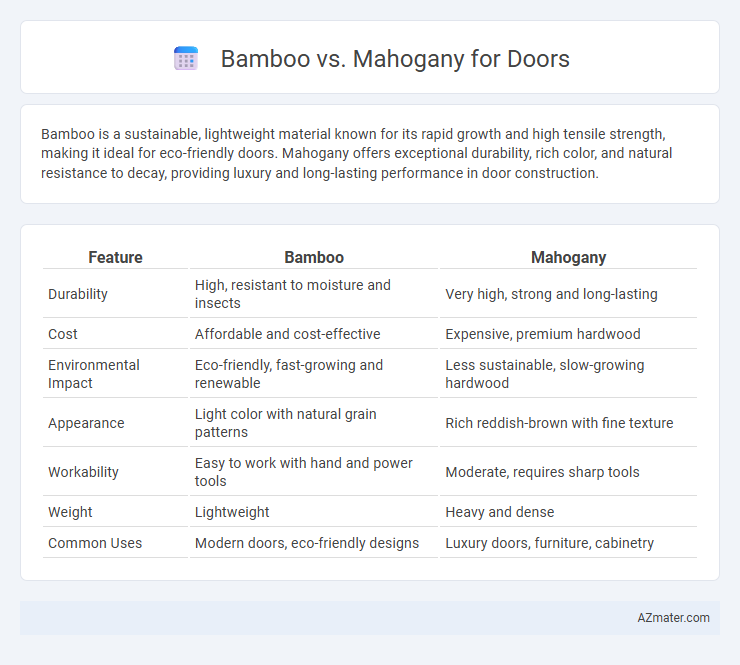Bamboo is a sustainable, lightweight material known for its rapid growth and high tensile strength, making it ideal for eco-friendly doors. Mahogany offers exceptional durability, rich color, and natural resistance to decay, providing luxury and long-lasting performance in door construction.
Table of Comparison
| Feature | Bamboo | Mahogany |
|---|---|---|
| Durability | High, resistant to moisture and insects | Very high, strong and long-lasting |
| Cost | Affordable and cost-effective | Expensive, premium hardwood |
| Environmental Impact | Eco-friendly, fast-growing and renewable | Less sustainable, slow-growing hardwood |
| Appearance | Light color with natural grain patterns | Rich reddish-brown with fine texture |
| Workability | Easy to work with hand and power tools | Moderate, requires sharp tools |
| Weight | Lightweight | Heavy and dense |
| Common Uses | Modern doors, eco-friendly designs | Luxury doors, furniture, cabinetry |
Introduction: Bamboo vs Mahogany Doors
Bamboo doors offer exceptional sustainability, rapid renewability, and remarkable resistance to moisture and pests, making them an eco-friendly choice for modern interiors. Mahogany doors provide unmatched durability, rich natural grain, and classic elegance, often prized for their strength and timeless appeal in traditional settings. Both materials exhibit unique qualities in texture, hardness, and maintenance, influencing their suitability for various architectural styles and environmental conditions.
Material Overview: Bamboo and Mahogany Explained
Bamboo is a highly sustainable, fast-growing grass with remarkable tensile strength and natural resistance to moisture, making it an eco-friendly choice for doors. Mahogany is a dense, hardwood known for its rich reddish-brown color, durability, and premium resistance to rot and insects, commonly used in high-quality, traditional door construction. Both materials offer distinct aesthetic and functional benefits: bamboo provides a modern, lightweight option with excellent environmental credentials, while mahogany delivers timeless elegance and exceptional longevity.
Durability and Strength Comparison
Bamboo doors offer exceptional durability due to their high tensile strength and natural resistance to moisture and pests, making them ideal for both indoor and outdoor use. Mahogany doors are renowned for their dense hardwood composition, providing superior strength and long-lasting performance, particularly in high-traffic or heavy-use environments. While mahogany tends to resist warping and dents better, bamboo's rapid growth and sustainable harvesting make it a durable yet eco-friendly alternative.
Aesthetic Appeal: Natural Beauty and Grain
Bamboo doors showcase a sleek, uniform grain pattern with a light golden hue that enhances modern and minimalist interiors. Mahogany doors feature rich, deep reddish tones and intricate, swirling grain patterns, lending a classic, luxurious aesthetic. The natural variation in mahogany grain adds unique character, while bamboo's consistent texture provides a clean, contemporary look.
Environmental Impact and Sustainability
Bamboo is a rapidly renewable resource that grows up to 3 feet per day, making it one of the most sustainable materials for doors, with a low carbon footprint and minimal deforestation impact. Mahogany, while durable and aesthetically appealing, is often harvested from slow-growing tropical hardwood forests, contributing to deforestation and habitat loss if not sourced from certified sustainable plantations. Choosing bamboo over mahogany significantly reduces environmental degradation and supports sustainable forestry practices aligned with global conservation goals.
Cost Analysis: Initial and Long-Term Investment
Bamboo doors generally offer a lower initial cost compared to mahogany, making them an economical choice for budget-conscious buyers. Over the long term, bamboo's rapid renewability and resistance to warping reduce maintenance expenses, enhancing overall affordability. In contrast, mahogany's higher upfront price reflects its premium durability and aesthetic appeal, but requires occasional refinishing to maintain its value, leading to higher long-term investment.
Maintenance Requirements and Longevity
Bamboo doors require minimal maintenance due to their natural resistance to moisture and pests, making them ideal for humid environments. Mahogany doors, while requiring regular polishing and protection from excessive moisture, offer exceptional longevity due to their dense, durable hardwood structure. Proper maintenance can extend the lifespan of mahogany doors beyond 50 years, whereas bamboo doors typically last around 20 to 30 years with standard care.
Resistance to Pests and Moisture
Bamboo offers superior resistance to moisture due to its natural silica content, making it less prone to warping and swelling compared to mahogany. Mahogany, while dense and durable, is more susceptible to termite infestations and requires regular treatment to maintain its pest resistance. For door applications, bamboo's pest and moisture resistance contribute to greater longevity and lower maintenance in humid environments.
Installation and Customization Options
Bamboo doors offer easier installation due to their lightweight structure and consistent grain, allowing for quick adjustments and fitting. Mahogany, known for its dense and heavy nature, requires precise handling and professional installation to avoid damage and ensure proper alignment. Customization options for bamboo include a variety of stains and finishes to highlight its natural eco-friendly appeal, while mahogany provides a rich, luxurious look with extensive carving and intricate detailing possibilities for high-end bespoke designs.
Final Verdict: Choosing the Best Wood for Your Door
Bamboo offers exceptional durability and eco-friendliness, making it an ideal choice for sustainable door construction, while mahogany provides superior hardness, rich color, and natural resistance to decay and insects, ensuring a luxurious and long-lasting finish. For high-traffic areas or environmentally conscious homeowners, bamboo doors combine strength with renewable qualities, whereas mahogany doors excel in aesthetic appeal and traditional elegance. Selecting the best wood for your door depends on balancing sustainability, durability, and design preferences, with bamboo favored for cost-effectiveness and environmental impact and mahogany prized for premium quality and classic beauty.

Infographic: Bamboo vs Mahogany for Door
 azmater.com
azmater.com